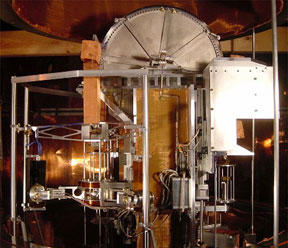
In support of a proposal to revise the International System of Units (SI) so that it would be based on constants of nature, NIST efforts such as the watt balance experiment (pictured) offer new ways of determining an accurate value of the Planck constant h, thereby contributing to a definition of the kilogram based on physical constants.
Taking the first steps of what would be a major historical advance in the science of measurement, the National Institute of Standards and Technology (NIST) is participating in a worldwide effort to recommend major revisions to the International System of Units (SI), the modern metric system that is the basis of global measurements in commerce, science and other aspects of everyday life. The new SI, which would be based on seven constants of nature, would enable researchers around the world to express the results of measurements at new levels of consistency and accuracy.
The most significant change in the possible future revision of the SI would be in the kilogram, the only one of the SI's seven base units* still defined in terms of a material "artifact": a 130-year-old platinum-iridium cylinder maintained at the International Bureau of Weights and Measures in France. The kilogram artifact poses long-term problems because its mass changes slightly over time. The proposed revision "puts the SI on a firm foundation," says Ambler Thompson, a NIST scientist involved in the international effort. "We get rid of the last artifact."
In the current SI, it's not just the unit of mass that depends on the kilogram. The definitions of the ampere (electric current), mole (amount of substance) and candela (luminous intensity) ultimately depend on the platinum-iridium artifact. For example, a mole is currently defined as the number of carbon-12 atoms whose total mass is 12 grams.
The new proposal defines the kilogram in terms of the Planck constant h**, an important constant in quantum physics, which is expressed in units containing the kilogram. Efforts at NIST such as the watt balance experiment and determinations of the mass of one mole of silicon atoms offer new ways of determining an accurate value of h, thereby contributing to a more reliable definition of the kilogram.
The new SI would specify agreed-upon values of the seven constants, according to the results of an analysis published by CODATA (Committee on Data for Science and Technology)of all of the relevant data. Fixed values of constants would then define all base units. For example, the ampere would be formally defined in terms of the electric charge of a proton, the kelvin (temperature) in terms of the Boltzmann constant***, and the mole in terms of the Avogadro constant. However, before the revised SI could be implemented, additional experiments are needed to obtain more accurate values for some of the constants, especially the Planck, Avogadro, and Boltzmann constants.
The Consultative Committee for Units, of which NIST is a member and which is one of 10 advisory committees of the International Committee for Weights and Measures (CIPM), submitted its proposal for a revised SI for consideration by the CIPM during its meeting in Paris, France, earlier this month. The CIPM, whose membership includes Willie May, director of NIST's Material Measurement Laboratory, modified and approved this proposal on Oct. 15, 2010. Based on this proposal, the CIPM will soon submit a resolution on a possible future revision of the SI for consideration at the next meeting of the General Conference on Weights and Measures (CGPM), the international diplomatic body that has the authority under the Meter Convention to adopt such a sweeping change. If the resolution passes and all the technical requirements it sets out are in place, a new SI could be adopted later in the decade.
* The seven SI base units from which all others are derived are the second (time), the meter (length), the kilogram (mass), the ampere (electric current), the kelvin (thermodynamic temperature), the mole (amount of substance) and the candela (luminous intensity).
** Current accepted value: 6.626 068 96(33) x 10-34 kg m2/ s
***The Boltzmann constant relates the change in the temperature of a system (such as a group of atoms and molecules) to the change in its thermal energy.
Edited on Nov. 2, 2010, for minor wording changes requested by BIPM.

